Originally written by Clair Rogers; Updated on My 26, 2025 by Candice Criscione to include details from our latest visit
Is Matera worth visiting? Yes! This small city in the Basilicata region is in a part of Southern Italy that often gets overlooked. It’s one of Italy’s most unique destinations. Everyone talks about how there’s nowhere in the world like Venice. Well, there’s nowhere in the world like Matera!
What is special about Matera? The city is made up of two large sassi (the stones) – Barisano and Caveoso, which were dug into to create caves that house homes, hotels, restaurants, shops, cafes, art galleries, and museums. Matera has a third part – Civita, the city, which used to be the main part of the city and the sassi dwellings were outside of the city walls.
This page contains affiliate links. If you purchase from the links, we may earn a small commission, at no extra cost to you. Please see our Disclaimer for more information.
Check out our post with 200+ Italy Travel Tips!
Map of Matera
You can see the main areas of Matera shaded on the map. The borders aren’t exact, but this should help give you an idea of the layout of the city:
- Sasso Barisano (blue)
- Sasso Caveoso (purple)
- Civita (yellow)
- Piano (red)
The sassi (rocks) – Barisano and Caveoso are the ‘cave’ parts of town, Civita is the upper part of town that sits between the sassi (where ther wealthy of Matera lived), and Piano is the more modern part of Matera.
History of Matera
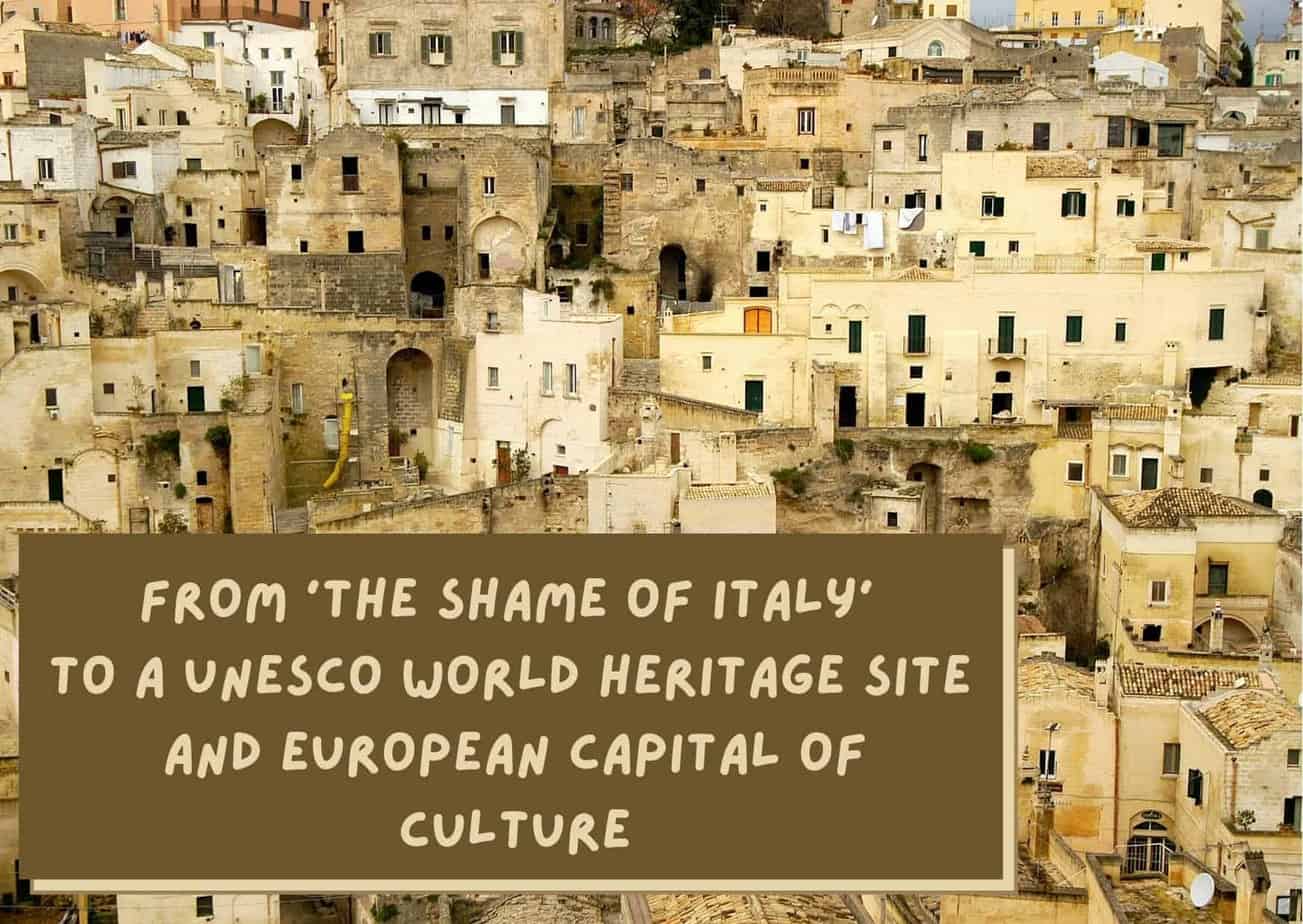
It’s said that the sassi have been inhabited for around 10,000 years. It is one of the oldest settlements in Italy and probably one of the oldest in the world. Archaeologists have found artifacts in the city’s caves dating back to pre-Neolithic times.
The cave dwellings were originally an ingenious system, almost like an oasis in the desert. Humans expanded on what nature already offered. Calcareous caves that were formed naturally over the centuries were inhabited and expanded on by their settlers. The Basilicata region is arid and dry, but the city had a system of cavernous cisterns that were nothing short of an engineering miracle.
Over the centuries Matera flourished. It was an important stop on the transumanza (where herders pass through with their sheep) and played a vital part in the wool trade, but in the 20th century with the invention of artificial fabrics and cheaper wool sources it began its steep decline.
What had been a city with a continuously inhabited, unbroken line from pre-history to modernity that was unique in the whole of Europe became a ‘national disgrace’, with inhabitants living in rudimentary conditions with no running water or electricity and sleeping alongside their animals.
The people of Matera lived quietly in poverty until author/political activist Carlo Levi was confined to exile in the nearby town of Aliano because he was anti-fascist. While there, he visited Matera and wrote about it in his book, Christ Stopped at Eboli, published in 1945. His writing brought the area and its squalor into the national spotlight and led to the area being called the shame of Italy.
In 1954, the Italian government built 3 new areas of public housing around the city, moving almost 20,000 local residents out of the sassi. While some may have been unhappy, most were more than happy to trade their stones for indoor plumbing and formica.
For decades the sassi remained uninhabited, but Pier Paolo Pasolini’s film ‘The Gospel According to Matthew’ brought this landscape and its beauty, with no signs of modernity at all, back into the national consciousness. It resembled an Italian presepe, or nativity scene, and was the perfect setting to represent the Holy Land and Jerusalem.
Slowly but surely the sassi were rediscovered and hippy squatters, artists and the simply curious began to populate the caves once more in the ‘60s and ‘70s. However, it remained a ‘dangerous’ place to most of the local community, associated with drugs and delinquency.
Over time, however, many of the locals wanted to restore the sassi, a proud part of their culture. In the 1980s, government grants allowed this process to begin.
In 1993 it became a UNESCO World Heritage Site, with the organization’s reason being that it is ‘the most outstanding, intact example of a troglodyte (cave-dwelling) settlement in the Mediterranean region, perfectly adapted to its terrain and ecosystem.’
This brought more money and attention to Matera and its incredible sassi. The caves were perfectly suited to the Italian concept of ‘un albergo diffuso’, where tourist accommodation is spread over several buildings. The caves had their own renaissance and quickly began to house luxury hotels, bars, B&Bs, restaurants, business start-ups, museums and arts organizations.
It was the ultimate revenge on the city’s detractors when the ‘national disgrace’ became the European Capital of Culture in 2019, proving what its inhabitants had always known: that Matera is a national treasure.
Visiting Matera in 2025

Matera is definitely ‘discovered,’ and the challenge remains to keep it a living, breathing city for locals. It is a true one-of-a-kind and feels like it’s off-the-beaten-path compared to other destinations in Italy (at least in the spring, fall, and winter).
It’s worth spending 2 days or 3 days discovering the city and the surrounding area. You’ll be missing out if you just stop in for a few hours on a day trip or bus tour.
You’ll need your comfortable walking shoes (with tread!) for Matera. The sassi are filled with stone steps and paths to climb and explore. The old city is located on a rocky shelf overlooking the spectacular Gravina Canyon.
On one side of the Canyon is the city with its Sasso Caveoso and Sasso Barisono districts (which you can take a day or two to discover) and on the other side is the Murgia Materana Park (Parco della Murgia Materana), which although close by can be a separate half-day trip (or a whole day if you want to explore it thoroughly). There is also a Tibetan bridge to cross the ravine (now reopened, after being closed for safety reasons in May 2023 due to a large part of the rock wall near the eastern side getting ready to fall down).
The Murgia National Park is home to one of Matera’s most important attractions: the Chiese Rupestri. These are churches (156 of them!) housed inside caves with incredible frescoes by a community of Benedictine monks. They date back to 700-800 A.D.
As well as the churches, the park also has some amazing wildlife, like foxes, hares, porcupines, red kites, and kestrels (the park’s symbol) and it’s a great place to hike.
13 Best Things To Do In Matera, Italy
Get A Feel For The History Of Matera
I’d definitely recommend visiting one or more of the following to get a visual look at Matera’s history and to see how people of Matera lived in the sassi in the past.
Casa Noha – A family’s dwelling that was donated to the government, the Casa Noha is now a small museum with a video tour. It’s a quick stop and worth seeing before you explore town. I appreciated seeing the videos of life in Matera in the past.
Vico Solitario Museum – See how people lived in one of the cave dwellings. Another excellent way to see daily life in Matera in the past. Being inside really helped me (and my son) imagine what it was like to live in Matera.
Museo Laboratorio della Civilta Contadina – Another look at life in the cave dwellings, but it’s much larger, so will take more time. Stop here if you want an in-depth look; otherwise, visit Casa Noha and/or Vico Solitario.
National Archaeological Museum – Stop here if you’d like to see some of the artifacts found in Matera and the surrounding area. There are also temporary exhibitions that may be worth a look.
Sassi in Miniatura – A fun look at the sassi in miniature form. Don’t miss it if you’re coming with kids!
Stroll Via del Corso & Via Ridola
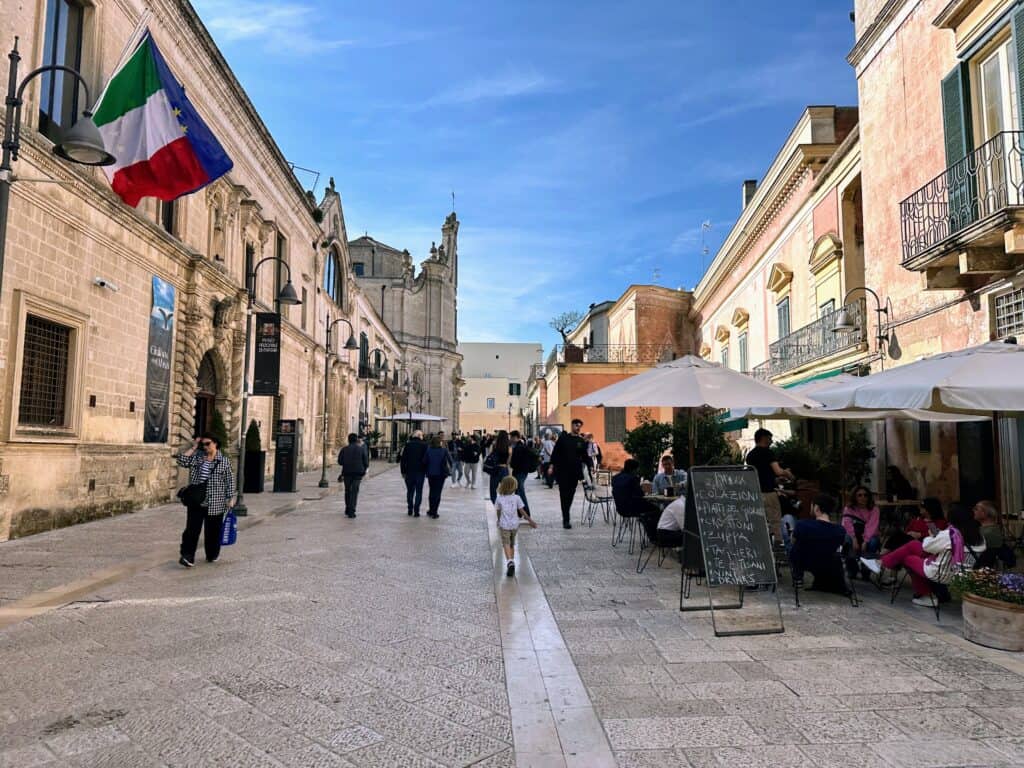
This is Matera’s main road. Wander it and check out its shops and restaurants and find your favorite viewpoint. The streets are busy in the day and at night. I usually try to avoid crowds, but we loved the energy and cheerful vibe here.
Visit Matera’s Unique Churches

Santa Maria de Idris (Madonna de Idris) – Incredible to see from the outside, but choose to explore the more interesting insides of the other churches.
San Pietro Barisano – The 12th-century church’s decorations were stolen in the 60s and 70s and it now has an eerie vibe. You can see small catacombs underground. The view from the church is spectacular.
San Pietro e Paolo al Caveoso – Dramatic setting on the edge of the ravine. Go inside to see the painted ceilings.
Chiesa del Purgatorio – Not a rock church, but worth visiting to see where people prayed for those in purgatory. Can you find the skulls?
Santa Lucia alle Malve – See the tombs on the roof of the church, interesting frescoes inside.
Check Out The Cava Del Sole
If you’re in Matera at the right time, see a concert in the old abandoned quarry. The acoustics are incredible!
Explore Palombaro Lungo
While it may not sound like a worthwhile stop on a Matera visit, this system of cisterns (Matera’s unique water collection method) has a dramatic setting and is interesting to see.
Find Your Favorite Viewpoint In Matera
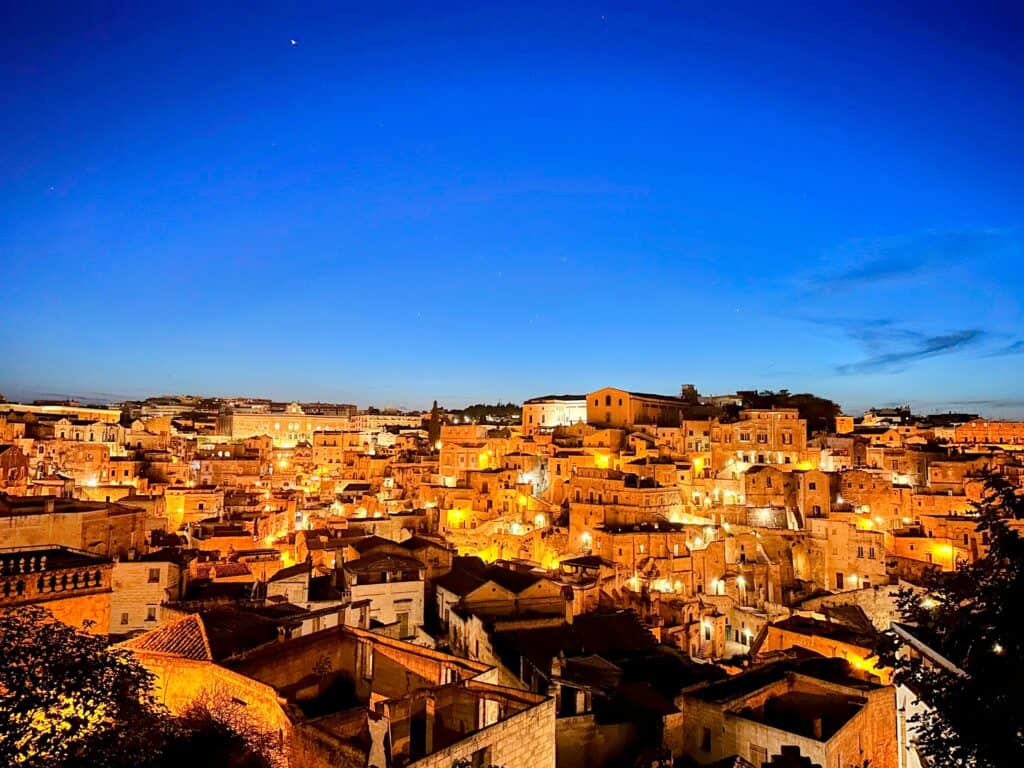
The ‘best’ viewpoint is hotly debated – go exploring and decide for yourself! You’ll probably love the viste at:
- Belvedere Piazzetta Pascoli
- Belvedere Luigi Gurrigghio
Climb The Duomo Tower
Climb the 170ft tower of the 12th century Duomo to see a great view of the gorge.
Hike Along The Gorge
Did your view from the Duomo inspire you to hike along the Gorge? The Belvedere Hike in the Parco Regionale della Murgia Materana takes about 2 hours out-and-back (4km, 700m elevation gain). It brings you to a hill that overlooks Matera. Note: I haven’t done this hike, so I can’t give personal feedback on it.
Explore The Rupestrian Churches In The Murgia Materana Park
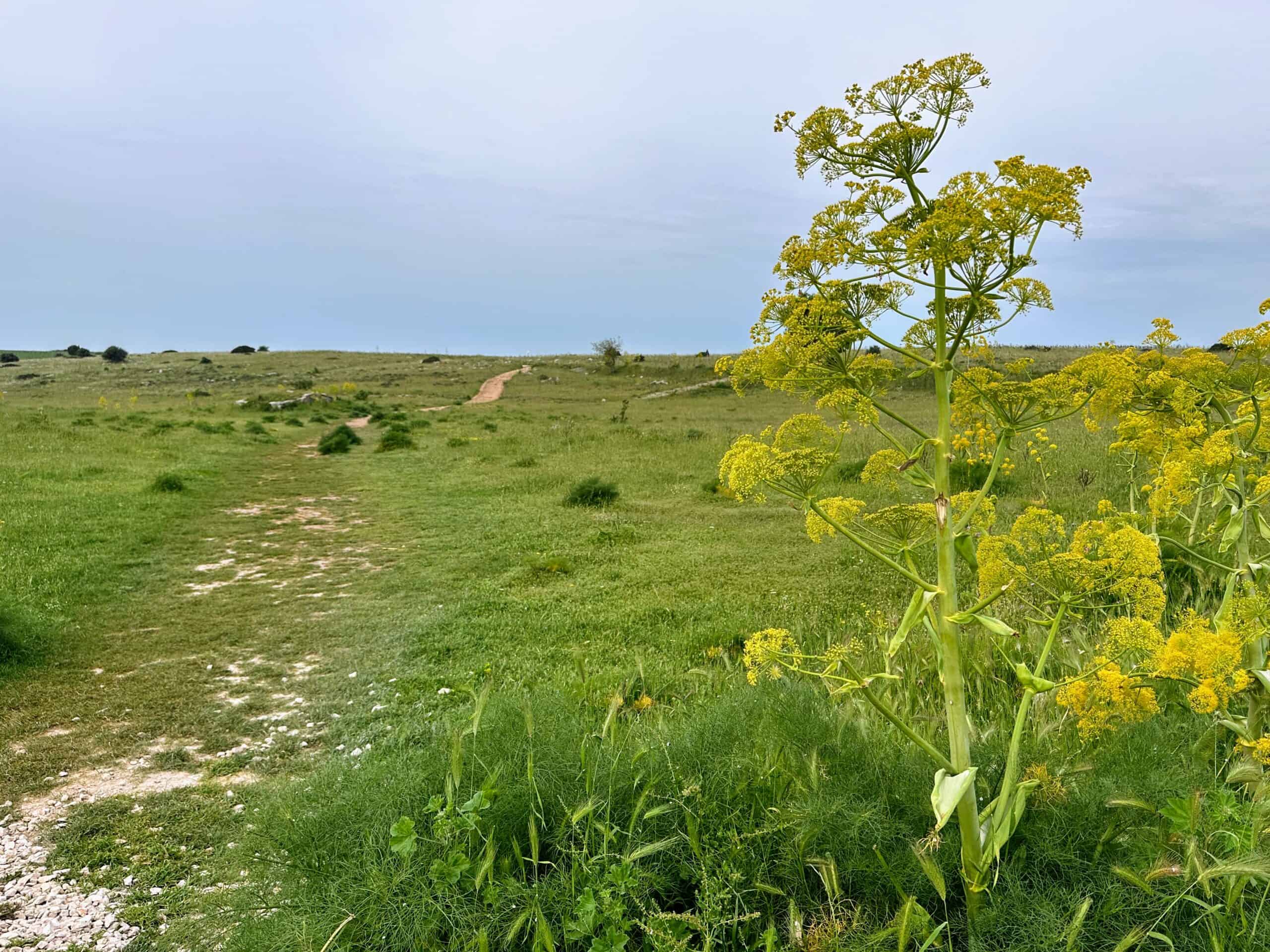
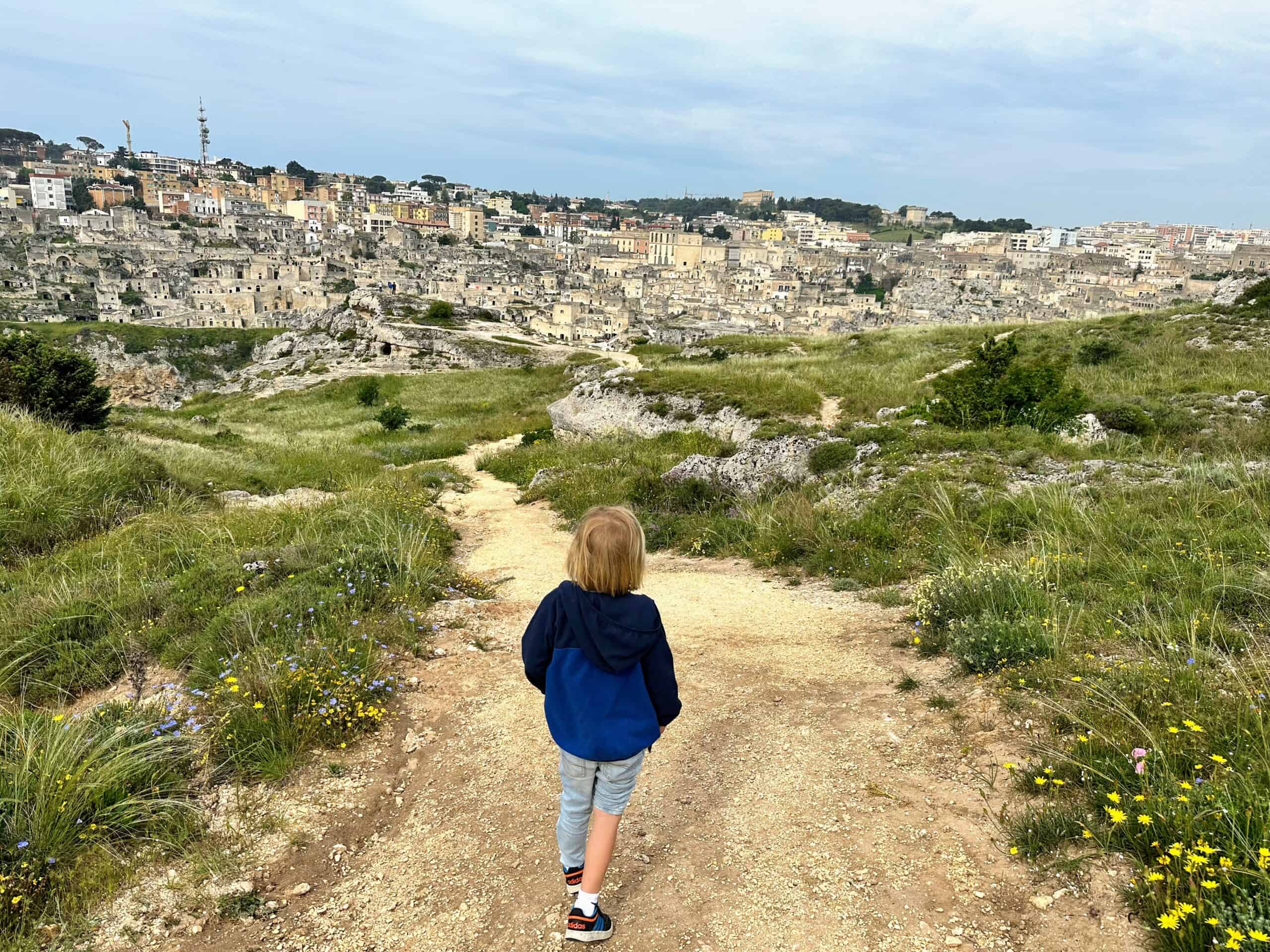
The churches and caves aren’t all clumped together, and some close periodically (for safety reasons). Your best bet is to hire a local guide to walk with you to make the most of your time. If you have time to explore, you can park in the main lot here and explore on foot. There are toilets and there’s a seasonal cafe in the building next to the small lot. You can’t drive any further, so you’ll need to walk the 1.6 kilometers (1 mile) to the Belvedere viewpoint of Matera.
Good To Know: It’s really hot in the summer and there is zero shade in the park.
I walked here early in the morning with my son and we loved being out in nature and seeing the views of Matera from across the valley. We walked to a couple of the cave churches and found them closed and difficult to see into.
See The Crypt Of The Original Sin
You’ll need to drive or take a shuttle to Contrada Perrapenta (about 20 minutes from Matera) to see the 8th-century frescos inside. It’s nicknamed ‘The Sistine Chapel of the Rupestrian Churches.’
Good To Know: You must make an advance reservation.
Go On A Walking Tour
While I’m a big fan of wandering and exploring on your own, local guides can really bring the place to live and give you fun facts, tell town ‘secrets,’ and help you see things you wouldn’t have noticed on your own.
Sassi Tour has multiple options to choose from, whether you’d prefer to stay in the Matera town center or explore the Murgia Materana Park.
Watch The Sun Set Over Matera
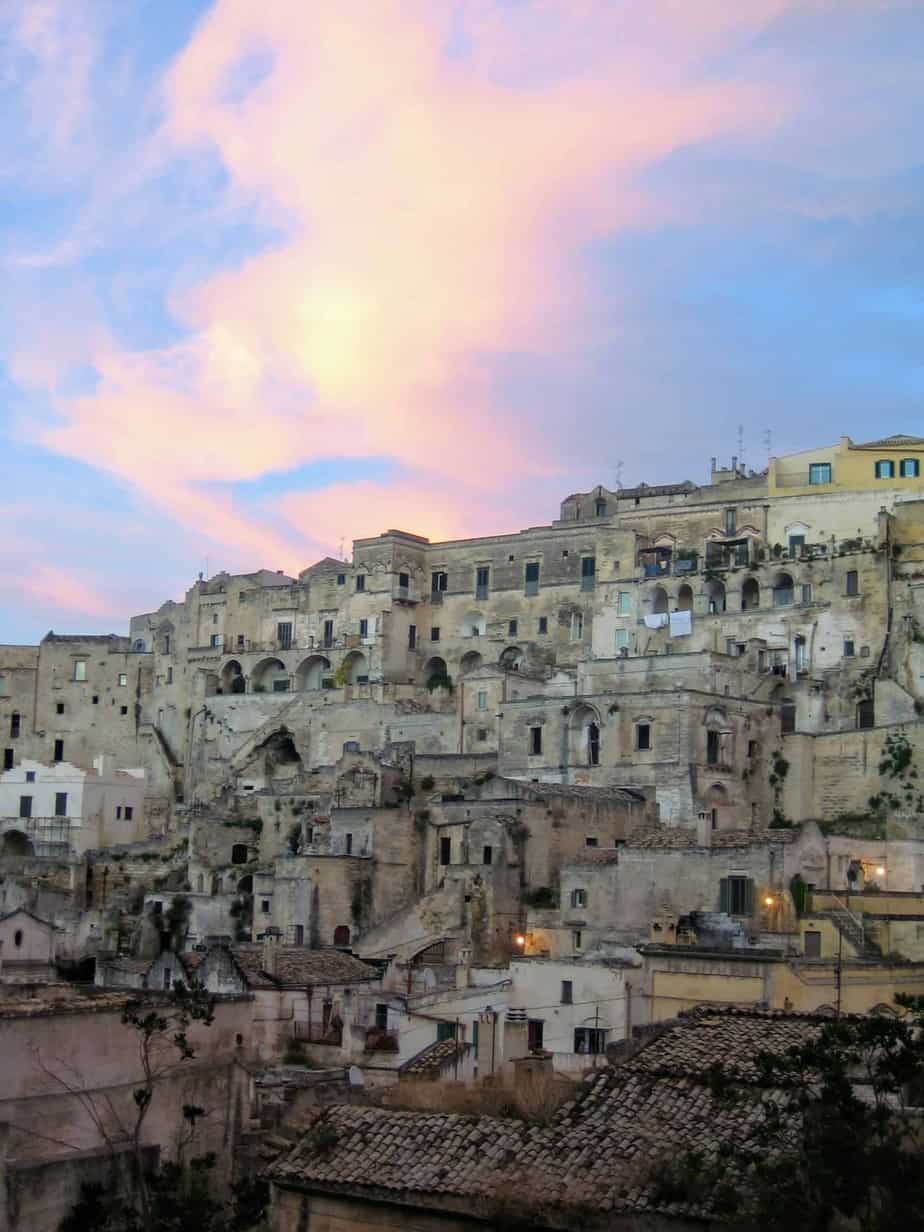
Whether you walk to a viewpoint or watch while having aperitivo, enjoy what the day-trippers and bus tourers don’t get – the dramatic sunset over Matera.
And after the sun sets, walk around the city at night. Matera lit up at night is also a must-see sight!
Get Artsy At MUSMA
While it’s not for everyone, if you enjoy modern art, don’t miss Matera’s Museum of Contemporary Sculpture. The artwork with the dramatic cave setting is worth a visit.
What To Eat In Matera

- Senise peppers or peperoni cruschi (from Senise, near Matera) – Enjoy them in powder form or whole in meat dishes, soups, and sometimes cheese. Or, savor them fried whole as a crunchy snack.
- Caciocavallo cheese – traditional cheese made from cow, sheep, or buffalo milk.
- Lucanica sausage – pork sausage with fennel or chilli pepper
- Bread of Matera – durum wheat and sourdough
- Rotonda eggplant – gorgeous round, sweet red eggplant (looks more like a tomato)
- Crapiata – soup with beans, lentils and potatoes
- Pignata – lamb and potatoes
- Aglianico del Vulture wine (produced in the Basilicata Region) or Matera DOC wine
- Orecchiette and cavatelli pasta
Where To Eat In Matera
- Trattoria del Caveoso – Nestled in the rock, this trattoria is the perfect place to sample regional specialties like crapiata or cavatelli con peperoni cruschi.
- Dimora Ulmo – Best bet for a gourmet tasting menu in Matera. Add the wine pairing to sample the region’s best vino and while you sip, enjoy the spectacular view. Salute!
- Keiv Ristorante (Piazza S. Pietro Caveoso) – Sit outside for views of the piazza and enjoy typical dishes. We loved the cicory and my son enjoyed the local cavatelli pasta.
- La Nicchia nel Sasso – Perfect restaurant for a romantic evening. Gorgeous view of Matera and the food is well-presented and represents the region well.
- 5 Lire Matera – Try to snag a spot on the balcony in the back. Then dig into a pizza, focaccia, or salad.
- La Lopa – You can watch movies downstairs at La Lopa. Often restaurants that try to do something other than serving food don’t do either well. La Lopa does – the food is fabulous and the creative entertainment is a bonus!
- Vitantonio Lombardo (one Michelin star) – Run by a young chef who has returned to his roots. Creative cuisine in a cave in Sasso Barisano.
- Il Forno di Gennaro – Stop here for a fresh taste of Matera’s signature pane (bread).
- I Vizi degli Angeli – Best gelato in town (according to us), in a quirky, colorful setting. Classic and creative flavors. Worth a stop, especially after a hot summer day in Matera!
Need tips on if/when/how to tip in Italy? Check out Tipping In Italy!
Where To Sleep In Matera
Spend the night in one of the sassi!
- Sextantio – Beautifully renovated and designed albergo diffuso (a hotel – usually with rooms ‘scattered’ throughout town – that wasn’t built to be a hotel, but offers hotel services).
- Caveoso Hotel – We stayed here on our latest visit. Cave hotel with amenities that make it comfortable. Nice breakfast and outdoor seating areas. Great location for exploring Matera.
- Aquatio Cave Hotel & Spa – Minimalist luxury hotel with spa.
- The View Matera (via Santa Cesare, Piazzetta San Biagio, 2) – Nice option for families – reserve an apartment with a kitchenette.
- La Dolce Vita B&B – Cozy B&B in the center of it all.
- Le Dimore dell’Acqua B&B – Perfect setting, convenient location, quiet and chic rooms.
- Palazzo Gattini – Luxury hotel in Matera. Stay here if you want to stay where Daniel Craig slept while filming in Matera.
Read more about
Matera Cave Hotels
Accommodation Options in Italy – From Agriturismos to Villas
Getting Around Matera

The best way to get around Matera is by foot. Be ready for a lot of hills.
The historic center was definitely not built for cars. The sassi only has a single drivable road, for locals, deliveries and drop-offs.
You can do an ape tour if your legs need a break.
Transport To Matera, Italy
Matera is not well-connected to other places in Italy, but it’s worth taking the effort to get to it.
Matera By Car
In my opinion, driving is the best way to get to Matera. It gives you freedom to explore the area around Matera and you can then head to other nearby regions like Puglia.
Be sure to read
Renting a Car in Italy
Car Rental at the Bari Airport
You can find parking around the FAL station. If staying in the sassi contact your hotel for details on luggage drops and transport into the sassi area. You’ll want to avoid entering the ZTL without permission.
Matera By Plane
Fly into Bari (63.5 km, around 40 miles) from Matera. Bus from Bari airport.
Matera By Train
You can take a train from Rome. It takes about 5.5 hours, with a change in Salerno. But, the train has a very limited schedule.
You can take a train from Bari (1.5 hours) on the regional Ferrovie Appulo Lucane (FAL). The FAL trains leave from their own separate station adjacent to the Bari Centrale Trenitalia station. The FAL station is only a 5-minute walk from the sassi of Matera and taxis are also available.
Read more about Train Travel in Italy
Matera By Bus
You can take a bus from multiple locations in Italy with Flixbus. There are also buses from the Bari airport.
Visiting Matera With Kids


What To Do With Your Kids In Matera
Kids will love exploring and finding their favorite aspects of the town. Make sure you visit the Vico Solitario Museum so they can see how children would have lived in the town in the past.
The underground cisterns also make quite an impression on children (and adults!).
Sassi in Miniatura is a nice stop for little ones.
They can play in the piazzas (not much traffic to worry about!).
If your kids (especially older kids and teens) enjoy walking and exploring, head out into the Murgia Materana Park.
If they get bored, give them a copy of this Printable Map of Italy For Kids, our Italy Word Searches, or Italy Coloring Pages!
I had a blast visiting Matera with my 5-year-old, but I can see how it would be difficult with smaller children because:
- there are a ton of steps
- the stone streets are smooth and sometimes slippery
- many places around town aren’t stroller friendly (your routes are limited with a stroller)
- there are some drop offs that don’t have good railings
- the natural park across the ravine has a lot of dangerous drop offs
Logistics With Kids In Matera
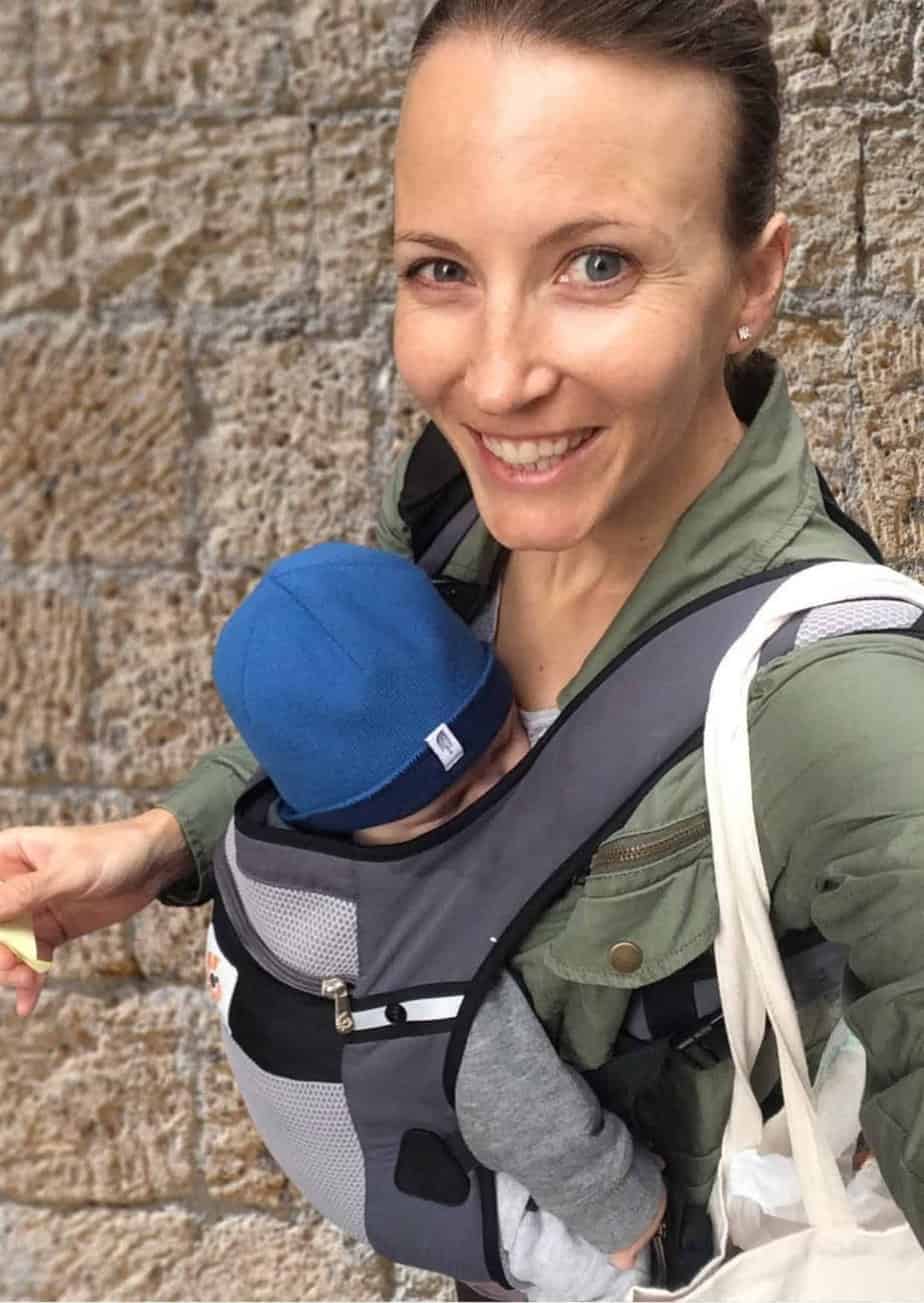
The terrain is fairly hilly so little legs may get tired quickly. Plan stops during your time at cafes or nice viewpoints.
Matera is not stroller friendly, so bring a baby in a carrier.
Highchairs are available in many restaurants – if you need one, be sure to call ahead.
Some hotels in Matera don’t allow children.
If you need baby supplies like diapers, wipes, or baby food, your best option is the pharmacy, or a grocery store (Coop on Via Manzoni).
As in many places in Italy, the city and accommodations aren’t child-proofed. Pay extra care to where your child walks as there are drop-offs, slippery steps, and other obstacles.
You may also want to check out
Matera with Kids
Italy with a Baby or Toddler
Italy with Teens
Italy Packing List for a Baby or Toddler
Italy Packing List for Kids
The Best Time To Visit Matera
Avoid the hot summer months of July and August. You’ll have pleasant weather from April – June, and September-October.
Weather In Matera
| Month | High | Low |
| January | 48°F (9°C) | 36°F (2°C) |
| February | 50°F (10°C) | 36°F (2°C) |
| March | 55°F (13°C) | 39°F (4°C) |
| April | 61°F (16°C) | 43°F (6°C) |
| May | 72°F (22°C) | 50°F (10°C) |
| June | 81°F (27°C) | 59°F (15°C) |
| July | 86°F (30°C) | 63°F (17°C) |
| August | 84°F (29°C) | 63°F (17°C) |
| September | 75°F (24°C) | 57°F (14°C) |
| October | 66°F (19°C) | 50°F (10°C) |
| November | 57°F (14°C) | 43°F (6°C) |
| December | 50°F (10°C) | 37°F (3°C) |
Trying to decide when to visit Italy? Check out my monthly guides:
Italy in January
Italy in February
Italy in March
Italy in April
Italy in May
Italy in June
Italy in July
Italy in August
Italy in September
Italy in October
Italy in November
Italy in December
Events In Matera
Matera has events throughout the year but the main event is the Festa della Bruna. Each July 2nd, the town celebrates the patron saint of Matera. Alleyways are lit up and a papier-maché statue of the Virgin Mary is paraded through the streets on a carriage. The night culminates with a fireworks display.
Things To Do Near Matera
- Explore the abandoned village of Craco (where scenes from Christ Stopped at Eboli were filmed)
- Visit (by appointment) the Matera Space Center
- Stay in Francis Ford Coppola’s Palazzo Margherita
- Wander the streets of Aliano, the town where Carlo Levi was exiled
- See what remains of the 6th-century Greek Temple of Hera / Palatine Tables
- Zipline between the towns of Castelmessano and Pietrapertosa
- Taste local wines at the nearby Paternoster Winery
- Explore the conical stone homes of Alberobello, another UNESCO World Heritage Site
- Visit Montescaglioso Abbey and enjoy a wonderful meal at La Locanda dell’Abbate
Movies That Were Filmed In Matera
Scenes for many films have been shot in the dramatic and picturesque sassi, including:
No Time To Die (2021)
Ben Hur (2016)
The Passion of the Christ (2004)
Matera FAQ
Matera is one of the oldest settlements in Italy and probably one of the oldest in the world.
Yes, Matera is a safe place to visit. There are plenty of tourists in town, so you’ll want to take normal precautions like locking your door, removing valuables from your car, and keeping your wallet tucked away.
Yes, Matera is still worth visiting if it’s raining. There are plenty of places to visit even if it’s raining. Head indoors – inside the dramatic churches, into a restaurant that serves local specialties, inside one of the town’s museums, or down into the underground cisterns.
While you could visit Matera as a day trip, the town is worth at least 2 days. There’s so much to see and you’ll want to see Matera in the evening too.
Movies filmed in Matera include:
The Passion of the Christ (2004)
Ben Hur (2016)
Mary Magdalene (2018)
No Time To Die (James Bond) (2021)
Pasolini’s The Gospel According to St. Matthew (1964)
Beresford’s King David (1985)
Hardwicke’s The Nativity Story (2006)
Christ Stopped at Eboli (1978)
Wonder Woman (2017)






